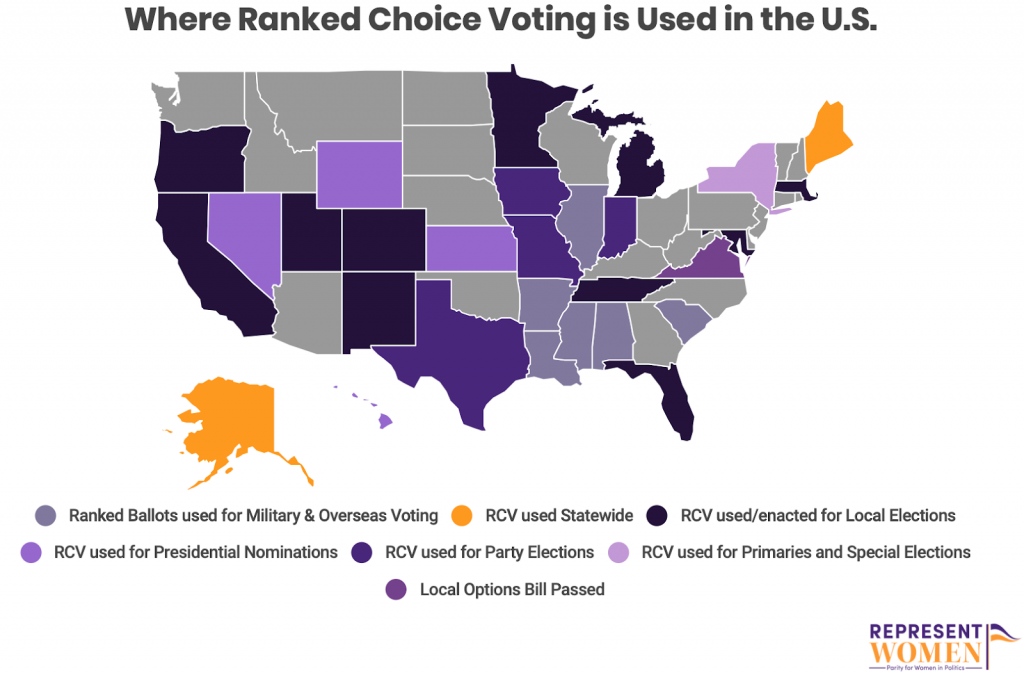Using multi-winner districts and ranked-choice voting in U.S. elections would dismantle the white male status quo in politics and help elect more women and people of color. Rep. Don Beyer’s Fair Representation Act will help to bring about this change.

In addition to the historic election of Kamala Harris as vice president and a record-breaking 117 women to the U.S. House, champions of women’s representation have another reason to celebrate: successful ballot initiatives for ranked-choice voting (RCV) across the U.S.
Six out of seven ranked-choice voting ballot measures passed this November, joining 18 cities, one county and one state that already use RCV in some capacity. But what exactly is ranked-choice voting, and how does it increase the number of women and people of color elected?
How Ranked-Choice Voting and Multi-Seat Districts Lead to Better Representation
In a ranked-choice election, voters rank candidates in order of preference. For a position that can only have a single officeholder, if one candidate earns a majority (50 percent + 1) of the first choice votes, that candidate wins.
If no candidate receives a majority of the votes, there is an “instant runoff,” where the candidate with the lowest vote total is eliminated, and voters who picked that candidate as their first choice have their votes re-allocated to their second choice. These “instant runoffs” continue until one candidate receives the majority of votes.
Ranked-choice voting can also be used in multi-seat jurisdictions, such as those currently held in Cambridge, Eastpointe and Minneapolis, and that will be held in Palm Desert and Albany, Calif., starting in 2022. In these cases, candidates must reach a share of the votes, based on the number of seats to be filled and total ballots cast. Once a candidate meets the predetermined threshold, surplus votes go towards the voters’ second choices. The candidate with the fewest votes is then eliminated, and voters who selected that candidate as their top choice have their votes re-allocated to their second choice. This system ensures that votes translate into seats accurately and that legislative bodies reflect the communities that they serve.
The U.S. primarily uses a single-winner plurality system, where candidates can win with less than majority support, especially in crowded fields. This system also reinforces the white male status quo in politics and disadvantages women and people of color by protecting incumbents and fostering negative and expensive campaigns. To combat these issues, FairVote and RepresentWomen advocate for “fair representation voting,” also known as multi-seat ranked-choice voting, proportional ranked-choice voting, or single-transferable voting.
According to the American Academy of Arts & Sciences’ Commission on the Practice of Democratic Citizenship, the combination of multi-seat districts (also known as multi-member or multi-winner districts) with ranked-choice voting in congressional elections “would encourage the participation of a wider array of candidates” in elections.
Furthermore, rather than “exacerbating the distortion of winner-take-all voting and drowning out minority votes,” multi-winner districts and ranked-choice voting together “would amplify the representational benefits of ranked-choice voting.” This change in particular would benefit women; the national average of women state legislators is 29 percent, compared to an average of 33 percent in states with multi-seat districts.

Pairing ranked-choice voting with multi-seat districts would also eliminate vote splitting and spoiler candidates, encourage issue-focused campaigns, and make elections more positive and affordable—all of which help women candidates.
The Tradition of Fair Representation Voting in the United States
While fair representation voting may seem novel, the system is far from new: Multi-seat districts and ranked-choice voting has a long and successful history in the United States.
In terms of district size, Article 1, Section 2 of the Constitution only specifies that members of the House of Representatives shall be apportioned according to the population of each state; it does not specify how representatives will be apportioned, though. As a result, the majority of the original 13 states adopted multi-seat districts for the first congressional elections. Before 1842, 31 percent of House members were elected in multi-seat districts.
As new states joined the union, Congress passed several reapportionment acts modifying district design. While the 1842 Apportionment Act required that congressional districts be single-member districts, several states resisted the change and continued to use multi-seat districts until the 1967 Uniform Congressional District Act enforced the single-member district mandate. State legislatures, however, could continue using multi-seat districts, and the majority did so in at least one chamber throughout the 1960s.
Now, only 10 states use multi-seat districts in their state legislatures, and a mere two out of 10 use them to elect both houses of their legislature.
A considerable factor in the decline of multi-seat districts was the perception that they prevented Black candidates from being elected. Studies that suggested this, however, relied on data from the 19th and mid-20th centuries, and did not account for confounding factors, such as election laws and discriminatory party rules, that were deliberately designed to prevent the election of Black candidates. Recent research has shown that candidates of color, especially women, are in fact more likely to run and win in multi-winner districts, and that their chances of success are even higher in a district that also uses ranked-choice voting.
Like multi-seat districts, ranked-choice voting is also deeply ingrained in U.S. electoral politics. It first emerged in 1912 in Ohio as a part of a reform effort to fight the disproportionate power enjoyed by party bosses and political machines. Between 1915 and 1935, five Ohio cities adopted legislation to elect their city councils with multi-seat ranked-choice voting. Under this system, Cincinnati, Hamilton and Toledo elected their first Black representatives, and in Cincinnati, where no woman had previously been elected, eight women won city council seats during the first five ranked-choice elections.
Shortly thereafter, ranked-choice voting began to spread across the United States. New York City and Cambridge both adopted multi-seat ranked-choice voting, which led to the election of a greater number of women and minority candidates—just like it had in Ohio. In New York City, for example, the move to multi-seat ranked-choice voting led to the election of Adam Clayton Powell Jr., the city’s first Black councilman, and Genevieve Beavers Earle, the city’s first woman councilperson.
The success of ranked-choice voting in electing more representative legislatures, however, eventually led to its repeal. Party bosses and business interests feared the growing political power of women and people of color and began to spread anxiety about race among the voters. In Ohio, ranked-choice voting was repealed after multiple ballot initiatives by 1957, and in New York City, it was repealed in 1945. By 1962, only Cambridge continued to use the fair representation system. It would take nearly 40 years for another jurisdiction to adopt multi-seat ranked-choice voting.
Not only has ranked-choice voting received support from U.S. municipalities and reformers for decades, but other countries and private institutions also endorse the system. Ireland and Malta all use multi-seat ranked-choice voting to elect their national legislatures; Australia uses it to elect their upper house; and Nepal, New Zealand and the United Kingdom also use this system in some local level elections. In addition, since 2009 ranked-choice voting has been used to decide all Oscar winners.
Looking Forward: The Fair Representation Act
While the recent success of ranked-choice voting ballot measures is a cause for celebration, we must continue to push for fair representation voting, combining ranked-choice voting with multi-seat districts, to have truly representative state and national legislatures. Representative Don Beyer’s (D-Va.) Fair Representation Act would help to bring about this change.
Under this act, all House districts would be drawn by independent redistricting commissions, all House districts would become multi-winner districts, and all members of the House of Representatives would be elected by ranked-choice voting.
The changes offered in the Fair Representation Act are not new, nor are they radical; rather, they are tested and common-sense solutions to the issues facing our democracy. They draw on a long tradition of ranked-choice voting and multi-seat districts in the United States—a tradition to which we should return to so our state and national legislatures reflect the diversity of the people they represent.
Up next:






